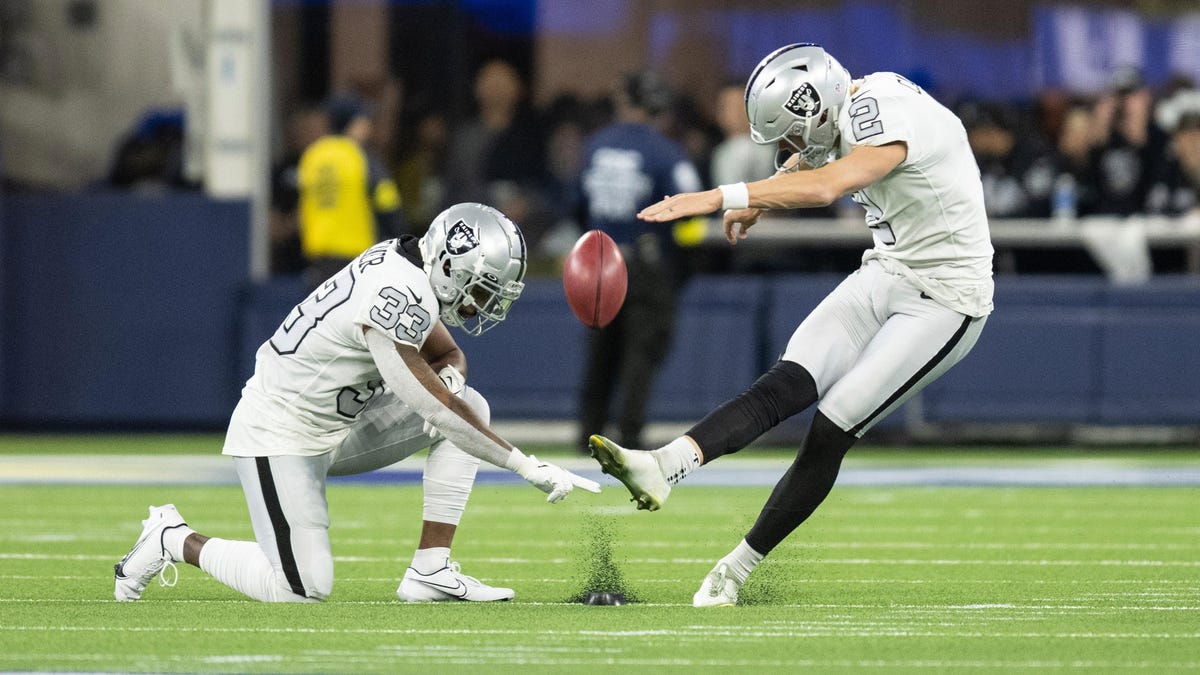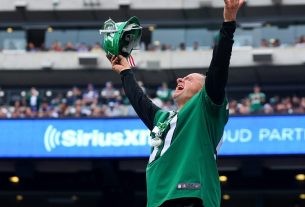
A week ago on Thursday Night Football, the NFL world paid witness to a pretty odd kickoff strategy from the Las Vegas Raiders during their game against the Los Angeles Rams. After the first drive of the game resulted in a Raiders touchdown, kicker Daniel Carlson had to boot the ball away, but he didn’t do so in a traditional fashion. Carlson opted for a holder, which is a totally normal thing in certain situations. If the ball consistently falls off the tee due to wind or other weather-related issues, kickers will often ask for help from a teammate to keep the ball on the tee. However, this game was being played at SoFi Stadium — indoors— meaning there were no weather issues to speak of. Why was the holder necessary then?
Several fans were confused at this sight.
Former Indianapolis Colts punter Pat McAfee offered a great explanation. Essentially, although having a holder reveals certain personnel decisions on the kickoff, the benefit is incredible if executed properly. McAfee explains that the holder isn’t holding the ball on the tee, but rather on the back end of the tee, giving the ball a little more height, allowing the kicker to get under the ball much easier. That added height, plus the opportunity to tilt the ball backward, gave Carlson a chance to kick the ball incredibly high up, resulting in kickoff hang times nearly equivalent to hang times from punts. That time with the ball in the air allows the kicking team to get down the field much quicker, before the receiving team can even start moving upfield. This resulted in several tackles behind the 20 or even 15-yard line, according to McAfee, which obviously would be a huge advantage in the field position department.
Even McAfee was flabbergasted at this discovery. He claims he even asked Raiders’ special teams coordinator Tom McMahon (although McAfee refuses to name him) about the legality of this maneuver, because if this was always legal, teams should’ve been doing it for a long time.
Well, it didn’t stay legal for long. Although it was originally approved by the NFL, yesterday, the NFL reversed its decision on the matter.
According to the report, the league decided to reconsider its stance on this elevated kickoff strategy following the Raiders-Rams game on Dec. 8. It also claims that the advantageous field positioning the kicking team gains from this strategy did not play into the decision to ban this maneuver.
“Since the holder is facilitating a placement that is not possible due to gravity, the officiating department reversed course.”
However, if the officiating department approved this action once, you’d think it would take an incredibly different interpretation of the rulebook in order to alter course, right? It’s not hard to imagine that the potential advantage played a role in the decision to ban this action. But was it really that helpful?
According to reports, the Raiders had been using this new-fangled kickoff technique for their last two games — Dec. 4 (home) and Dec. 8 (away) against the two L.A. teams. In those games, the Raiders performed 11 kickoffs — six against the Chargers, five against the Rams. The average starting field position for their opponents in these games was the 23.18-yard line — 21.5 average starting field position for the Chargers, 25.2 average starting field position for the Rams. There were four instances where the Raiders’ opponents started at the 25 or better — two touchbacks, two runbacks. There were only two instances where the Chargers or Rams had to start behind their own 20-yard line. Considering the NFL wants the average starting field position following kickoffs to be the 25-yard line, that doesn’t sound too bad, right?
But what about the return statistics? Is this increased hang time actually preventing big returns? Well, according to Pro-Football-Reference, the average kickoff return in 2022 is about 22.2 yards. In these two Raider games, their opponents’ average kickoff return was just 18 yards, over four yards fewer per return than the league average. That’s not normal, and it’s not an inconsequential amount.
Consider this. According to Pro-Football-Reference’s NFL Win Probability Calculator, an average NFL team is expected to score .607 points on a drive starting at their own 25. If a team starts a drive at their own 21, they are expected to score only .343 points, cutting their expected point total by 43.5 percent. That’s a monumental difference.
There is a huge advantage to what the Raiders were doing, so it only makes sense that the NFL would ban such a technique. While the NFL claims they banned it for different reasons, it’s hard to believe the NFL would allow it only to take it away two weeks later for any reason other than unfair play. Perhaps there was a safety issue involved, but if that were truly the case, the NFL probably would’ve come forward with that reasoning from the get-go. It would’ve been an acceptable reason and a good PR move considering the NFL’s tendency to shy away from player safety. Just ask DeVante Parker.
In all likelihood, the only reason the NFL banned this strategy was that it likely would’ve been adopted by the rest of the NFL. If every kicker in the league uses it, the average starting field position would decrease, which means scoring would decrease, and less scoring means fewer interested fans. Fewer interested fans mean less money, so for the sake of revenue, they had to nip this technique in the bud before it got out of hand.



